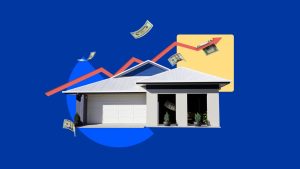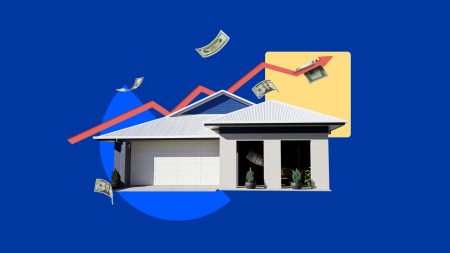Our writers and editors used an in-house natural language generation platform to assist with portions of this article, allowing them to focus on adding information that is uniquely helpful. The article was reviewed, fact-checked and edited by our editorial staff prior to publication.
Key takeaways
- A 5/1 ARM loan provides an initial fixed-rate period of five years, after which the interest rate adjusts yearly depending on current market rates.
- ARM loans have rate caps, a ceiling for how high your interest rate can go once the introductory fixed-rate period ends.
- A 5/1 ARM might be right for you if you plan to sell your home or refinance before the initial fixed-rate period expires.
An adjustable-rate mortgage (ARM) comes with an interest rate that changes over time. Typically, you begin an ARM paying a lower, fixed rate for a set period of time. After that fixed-rate time expires, your rate adjusts to the market rate, either higher or lower. The most common types of ARMs include 3/1, 5/1, 7/1 and 10/1 loans.
What is a 5/1 ARM?
A 5/1 ARM is one type of adjustable-rate mortgage. The “5/1” refers to the length of the fixed-rate period and the frequency of rate changes, respectively. The “5” is the fixed-rate period of the mortgage — the first five years. The “1” is how often the interest rate adjusts after that — once per year.
Another common mortgage is the 5/6 ARM, which adjusts every six months after the initial five-year period.
How does a 5/1 ARM loan work?
The clock starts ticking on your 5/1 ARM as soon as you close the loan. If you were to close the mortgage in July 2024, for example, your rate wouldn’t change again until July 2029.
When the adjustment happens after five years, the lender recalculates the interest on your loan going forward depending on how the rate has changed, up or down. One year later, your loan will adjust again, and the process will repeat to the end of the loan term. If your rate goes up, your monthly payment will also go up. The inverse is also true.
Important terms to know about 5/1 ARMs
ARMs are uniquely structured to allow for a lower introductory rate and subsequent adjustments, but your rate can’t just keep climbing indefinitely. On your closing documents, you’ll see the following:
- Introductory or “teaser” rate: This refers to the interest rate you’ll pay during the initial fixed-rate period.
- Adjustment intervals: This indicates the frequency at which the rate can change. It can also be referred to as the reset date.
- Initial adjustment cap: This cap is the maximum amount by which the rate can rise at the first adjustment, often 2 or 5 percentage points higher than the initial rate.
- Periodic rate cap: The periodic rate cap, also called the subsequent adjustment cap, is the maximum amount by which the rate can change each time it resets, typically 2 percentage points higher than the prior rate.
- Lifetime cap: This is the maximum amount by which the rate can change over the life of the loan. This varies by lenders, but is generally 5 percentage points.
Knowing the caps on how much your interest rate could increase can help you plan and budget for future payments after the initial fixed-rate period ends. Alternatively, if you think you wouldn’t be able to afford higher payments, then exploring a fixed-rate loan might be a better option.
Example of a 5/1 ARM loan
Let’s say you take out a 5/1 ARM loan for $300,000 with a 6.5 percent interest rate. For the first five years of the 30-year loan, your rate would be locked in at 6.5 percent, making your monthly payment about $2,045 during that time. With a 5 percent lifetime cap on your loan, your potential maximum monthly payment would be roughly $3,140.
You can use our adjustable-rate mortgage calculator to estimate your monthly payments and see how they might change over the loan’s term.
What index does the 5/1 ARM use?
The index is a major factor in determining the rate you pay on your ARM. ARMs are typically tied to the 11th District Cost of Funds Index (COFI) or the Secured Overnight Financing Rate, or SOFR. You can find out the specific index your lender uses on your loan estimate paperwork. If the yield on that index increases, your ARM rate also increases.
Pros and cons of a 5/1 ARM
Pros of a 5/1 ARM
- Cheaper to start: A 5/1 ARM has more affordable monthly payments, at least initially, compared with a 30-year fixed mortgage.
- Your rate could decrease after the initial period: If interest rates are falling, your monthly payment will also decrease after the initial period, and potentially during future resets.
Cons of a 5/1 ARM
- Could cost you much more: An ARM exposes you to higher rates after the fixed period is over. If rates have risen, your monthly payment will increase.
- Complexity: There are more moving parts to an adjustable-rate mortgage than a fixed one. Rate caps, indexes and resets can get pretty technical for the average borrower.
- Interest-only trap: Some ARMs allow you to make only interest payments, not principal, in the initial period. That can allow you to stretch your budget and lower your payment, but after the fixed period your payments will be much higher to include the principal. Aside from hurting your budget, if home values drop, you could find yourself underwater on the loan.
How 5/1 ARMS compare to other loans
- 5/1 ARM vs. other ARMs: Other ARMs, such as a 10/1 or 7/1 ARM, work in a similar way to 5/1 ARMs, except the length of the initial fixed-rate period and the interest rate will differ. For a 10/1 ARM, the initial rate is fixed for the first decade rather than five years, and for a 7/1 ARM, the initial rate adjusts after the first seven years. Rates likely will be slightly higher on a 10/1 and 7/1 ARM compared to a 5/1 ARM because they have longer introductory fixed-rate periods.
- 5/1 ARM vs. fixed-rate mortgage: The introductory fixed rate on a 5/1 ARM is often considerably lower than the one on a 30-year fixed-rate loan. That translates to a lower monthly payment, at least initially. Of course, the drawback is uncertainty. After five years, your ARM rate and monthly payment could rise. With a fixed-rate loan, you’ll know exactly how much you’ll pay over the life of the loan, making the payments easier to budget for.
When to consider a 5/1 ARM loan
An ARM can make sense if you don’t plan to be in the home long enough to see the first rate adjustment, such as if you plan to move again within the next 5 years.
— Greg McBride, CFA, chief financial analyst for Bankrate
If you’re in the market for a mortgage, a 5/1 ARM might be a good fit in a few situations:
- You plan to refinance or sell soon. If you don’t plan to keep the loan for more than five years, you’ll never deal with a rate adjustment. You’ll need to have a concrete plan for how you’ll get out of the loan, however, whether that’s moving or refinancing. If you want to refinance, keep in mind you’ll need to be able to qualify for it, as well as pay closing costs.
- You expect your income to increase over time. If you know you’ll be bringing in more income five years from now, you might be able to handle a potential increase in payment. This might be the case if you’re a doctor just coming out of medical school, for example, or in another profession with a similar lucrative earnings horizon.
- Your budget supports the maximum payment. If you’re well off financially, a bump in rate and payment might not matter much in your budget. This lowers the risk of rate adjustments considerably — but it also means you might not have as much left over for other financial goals, like investing or saving for retirement.
“The differential between the initial rate on an ARM and that of a fixed rate mortgage isn’t always the same, but the risk of future rate adjustments is always there,” says Greg McBride, CFA, chief financial analyst for Bankrate. “Sometimes the difference in [the] initial rate is slight enough that you don’t get enough benefit to justify the risk. An ARM can make sense if you don’t plan to be in the home long enough to see the first rate adjustment, such as if you plan to move again within the next 5 years. But even if you go this route, beware that if your initial timetable doesn’t pan out, you could face higher payments when the rate begins to adjust.”
5/1 ARM FAQ
-
When you take out a 5/1 ARM, there’s a chance your interest rate and payment could increase once the initial fixed-rate period ends. To prepare for an increase in your payment, you can budget accordingly or seek guidance from a housing counseling agency approved by the U.S. Department of Housing and Urban Development (HUD). You can also refinance your ARM loan to a fixed-rate mortgage if you can secure a lower rate and plan to stay in the home long enough to break even on closing costs.
-
ARM loans require a minimum credit score, though the exact number depends on the type of ARM. Conventional ARMs require a minimum credit score of 620, while FHA ARMs require a minimum credit score of 580. VA ARMs do not have a specific credit score requirement, but they do require a debt-to-income ratio of no greater than 41 percent.In addition, your debt-to-income ratio must be 43 percent or less (some lenders may accept no more than 50 percent). For down payments, conventional ARMs require a minimum of 5 percent down, while FHA ARMs require a minimum of 3.5 percent. VA ARMs do not require a down payment.
-
Borrowers with excellent credit scores are typically offered the best mortgage rates by lenders. You can also make a higher down payment, which decreases your loan-to-value ratio (LTV) and in turn can help you get a lower mortgage rate.You might think paying for mortgage points will also help you get the best initial interest rate on a 5/1 ARM, but this isn’t necessarily the smart move.
”It often takes five to six years before the cost paid for points upfront is recouped through the lower monthly payments,” says McBride. “Taking a 5/1 ARM makes sense if you plan to move within the next five years, but paying points to further reduce the rate would take longer than five years to recoup. If you have the cash to pay points, this is better suited when you plan to have the loan long enough to recoup the costs, such as a 10-year ARM or a fixed-rate mortgage.”
-
A convertible ARM is an adjustable-rate mortgage with a clause that allows you to convert your interest rate from adjustable to fixed after the initial fixed-rate period expires.
Read the full article here










